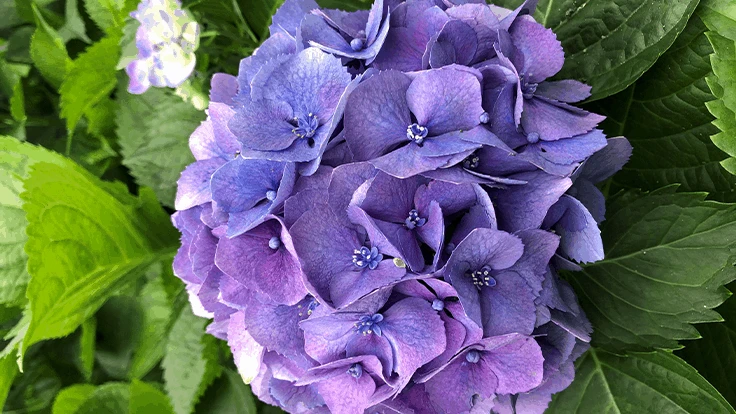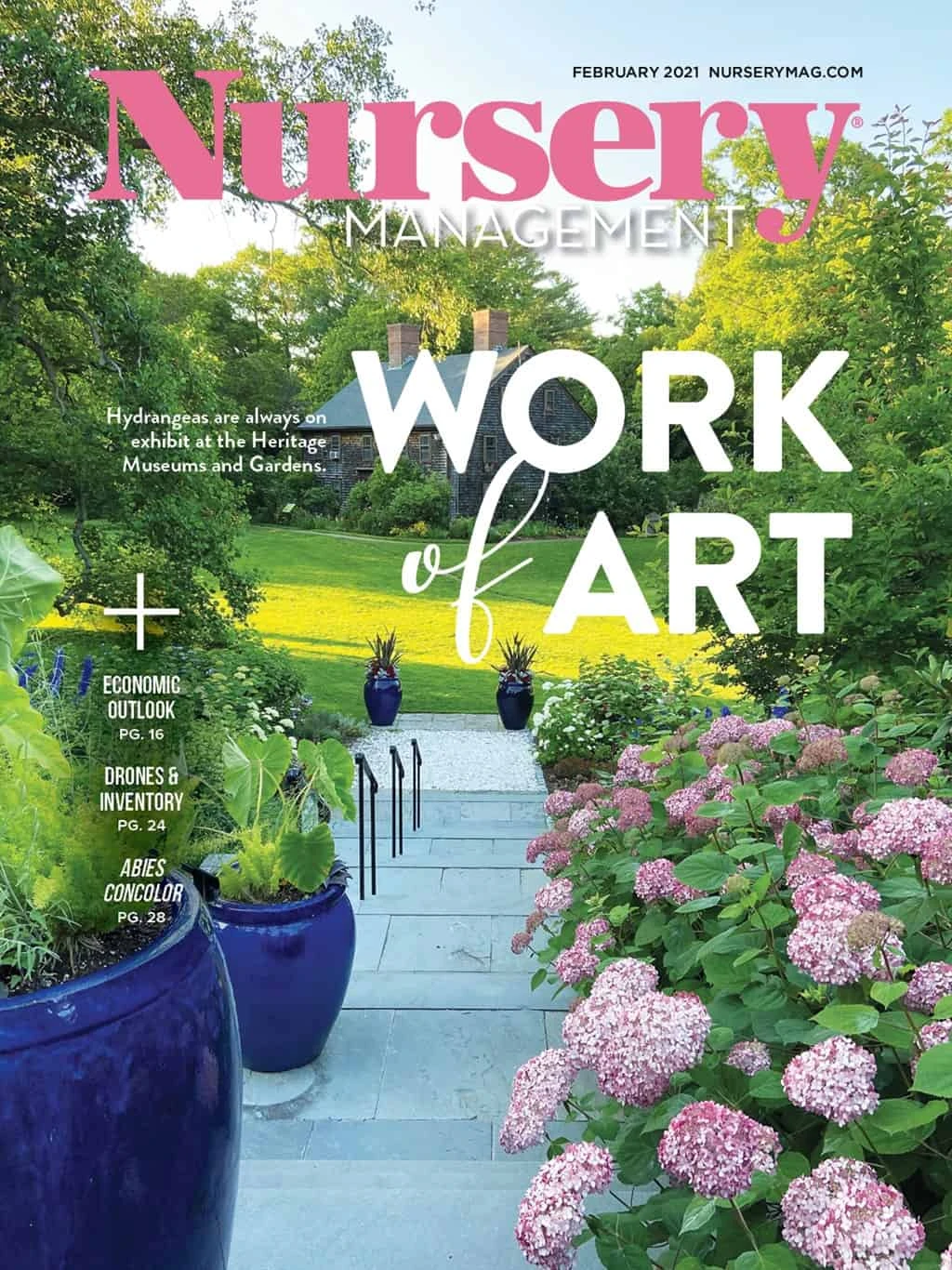

Cape Cod is home to many a hydrangeaphile. Landscapes in this historic and idyllic area of southern New England are adorned with some spectacular specimens. The Cape Cod Hydrangea Society is a lively and generous organization that has been educating the region about hydrangeas, what they call “the signature flower of the Cape.” And Heritage Museums and Gardens in Sandwich, Massachusetts dedicate an impressive number of man hours and space to hydrangeas throughout the grounds, including a display garden and a test garden.
Mal Condon is the curator of hydrangeas at Heritage. He’s been propagating and growing hydrangeas for 45 years. It only takes a few minutes chatting with Condon to realize he’s brimming with hydrangea knowledge and his love of this crop is genuine. With all of this ballyhoo surrounding hydrangeas, Cape Cod is a mecca of sorts for a crop that’s become quite valuable to the green industry.
“Hydrangeas are the No. 2 shrub behind roses, and I think they are so popular because of the magnificent flower,” Condon says. “With different species, you can have sequentially blooming shrubs and a summer full of hydrangea blooms. They are plants that home gardeners can handle very well and they get a lot of enjoyment from. I don’t see that changing.”
At Heritage, the hydrangea display garden came first. With nearly 2 acres, the display garden is a joint effort between the Cape Cod Hydrangea Society and the museum. Initial planting began in 2008 and continued through 2010 with relocations and expansions in 2012, 2013 and 2014. The display garden is home to eight hydrangea species and more than 160 cultivars. It’s maintained almost exclusively by the society.
“The display garden is made up most of macrophyllas, but we have a decent amount of paniculatas and serratas, as well,” Condon says. “We also have a lot of legacy varieties that aren’t typically available in the trade. I’m trying to locate some of the old arborescens cultivars.”
An idea takes shape
The test garden was the brainchild of Dr. Michael Dirr, whose hydrangea selections and breeding helped catapult the crop’s popularity. Dirr brought up the idea during the 2015 Hydrangea Conference at Heritage and before the end of the event, a plan was in place to move forward. Dirr, Bailey Nurseries, Star Roses & Plants, the American Hydrangea Society and the Cape Cod Hydrangea Society committed $100,000 total to initiate the test garden.
“I helped Heritage chase grants and asked people like Mark Sellew at Prides Corner, Tim Wood at Spring Meadow, Greenleaf and others for plant donations, and all responded positively,” Dirr recalls.
The test garden’s mission is to trial the newest hydrangea introductions across the species spectrum and report on performance, Dirr says. But there are some “old standards” included in the design for performance comparisons, Condon adds.

The North American Hydrangea Test Garden
Les Lutz, horticulture director at Heritage, designed the test garden, which includes sun and shade conditions for the hydrangeas, as well as hardscapes, water features and complementary perennials, shrubs and trees.
“Les created a beautifully designed garden that’s horticulturally rich and integrated with all manner of plants, no just test rows with ugly signage,” Dirr says. “The casual visitor would have to sleepwalk through the garden and not come away with new ideas.”
The test garden opened in the summer of 2016 with the goal of becoming the most comprehensive collection of the genus in the U.S., Condon says. As of June of 2020, there were 244 hydrangeas under evaluation, including: H. arborescens (35 plants and eight cultivars); H. macrophylla (136 plants and 21 cultivars);
H. paniculata (67 plants and 11 cultivars); and H. serrata: (three plants and 1 cultivar).
There’s a heavy emphasis on H. macrophylla in the test garden because it makes up the majority of commercial production.
“The macs are superb — they’re always tough and they have great texture and color diversity,” Condon says. “We talk a lot about the macrophyllas, but paniculatas and arborescens are bulletproof. They’re my favorites, and once established, they do so well for us.”
The macrophyllas are evaluated for their winter/bud hardiness, reblooming capability, bloom density, bloom quality, general growth and size characteristics, sun tolerance, and pest and disease pressure.
There is a lot of focus on reblooming capability at the test garden because the market puts a lot of emphasis on that characteristic. All stem tips are pinched in July — an action Condon calls their “most critical test” — to evaluate the number of new inflorescences that develop by late August and into September.
The test garden is located in USDA Hardiness Zone 6a, while the rest of the Cape is 7a. Soil prep is a critical step at the gardens where the soils are a glacial marine composition with stone, sand and clay veins, Condon says.
“We blend on-site produced compost with our inherent glaciated soil. In worse cases we screen the latter to remove the sometime major rubble content,” he explains.
Pruning is a two-step practice in late winter and early spring.

“Aging canes are removed first for regenerative pruning in March and early April. All vibrant wood is left until detail pruning is done in May when the failed upper stem wood is removed,” he says. “This seasonal pruning approach has sustained a very high percentage of vital wood while also maximizing flower bud development.”
Plants are not treated with insecticides or fungicides once they’re in the ground.
Condon’s crew applies a controlled-release fertilizer in spring of only 3-4 ounces per established plant for all hydrangea species. The typical N-P-K formulation is 14-3-17, he says.
All plants receive surface/drip irrigation. The garden installs emitter rings around each plant and “links them to create effective zone loops for absolute control of applied water volume and frequency of application,” Condon explains. “It has become our practice to install irrigation within a few days of completing any planting project. Overall, this irrigation approach has had a very positive impact on plant vigor, uniformity of growth, and reduced leaf spotting.”
It all comes down to helping breeders and growers analyze this genus to select the best performer and to perfect new cultivars, Condon says.
In 2020, the test garden named H. macrophylla Summer Crush as the best performer.
“Summer Crush has great pigmentation, and highly pigmented blossoms are en vogue these days,” Condon says.

In 2020, the test garden grew by about 30% and is now almost 3 acres. A group of volunteers nicknamed the Diggermen put in more than 300 hours, including the irrigation work.
“It was surprising what we were able to do and I’m so delighted with the expansion,” Condon says.
Heritage hosted a soft opening — with plenty of safety protocols in place — in August 2020.
For more: heritagemuseumsandgardens.org

Explore the February 2021 Issue
Check out more from this issue and find your next story to read.
Latest from Nursery Management
- John Ruter shares UGA's latest woody and herbaceous ornamental plant breeding projects
- Conor Foy joins EHR's national sales team
- Pantone announces its 2026 Color of the Year
- Syngenta granted federal registration for Trefinti nematicide/fungicide in ornamental market
- Get to know Kayela Aeppli
- HILA 2025 video highlights: John Gaydos of Proven Winners
- Q&A with Justin Bartlett
- Be the best choice





